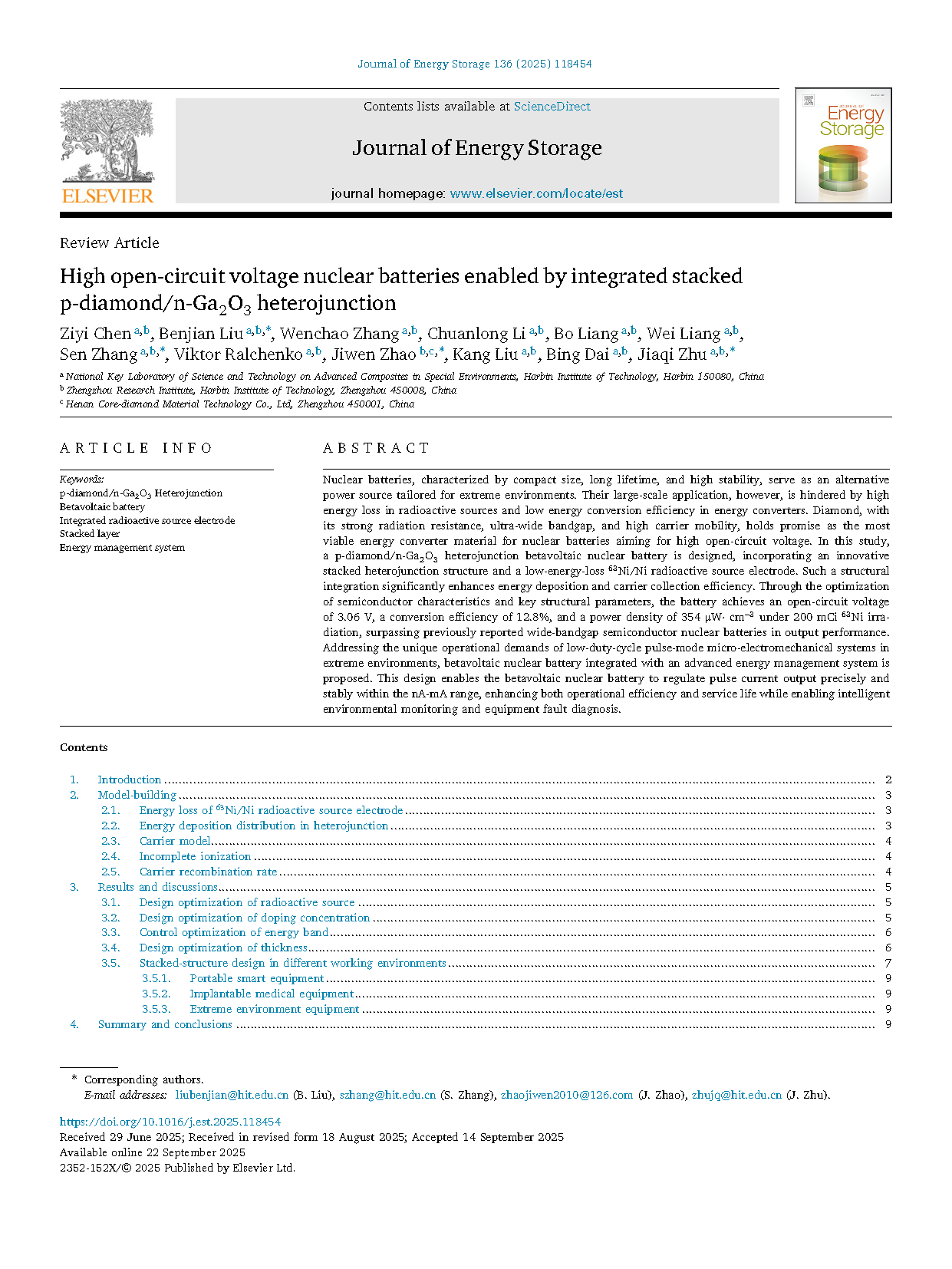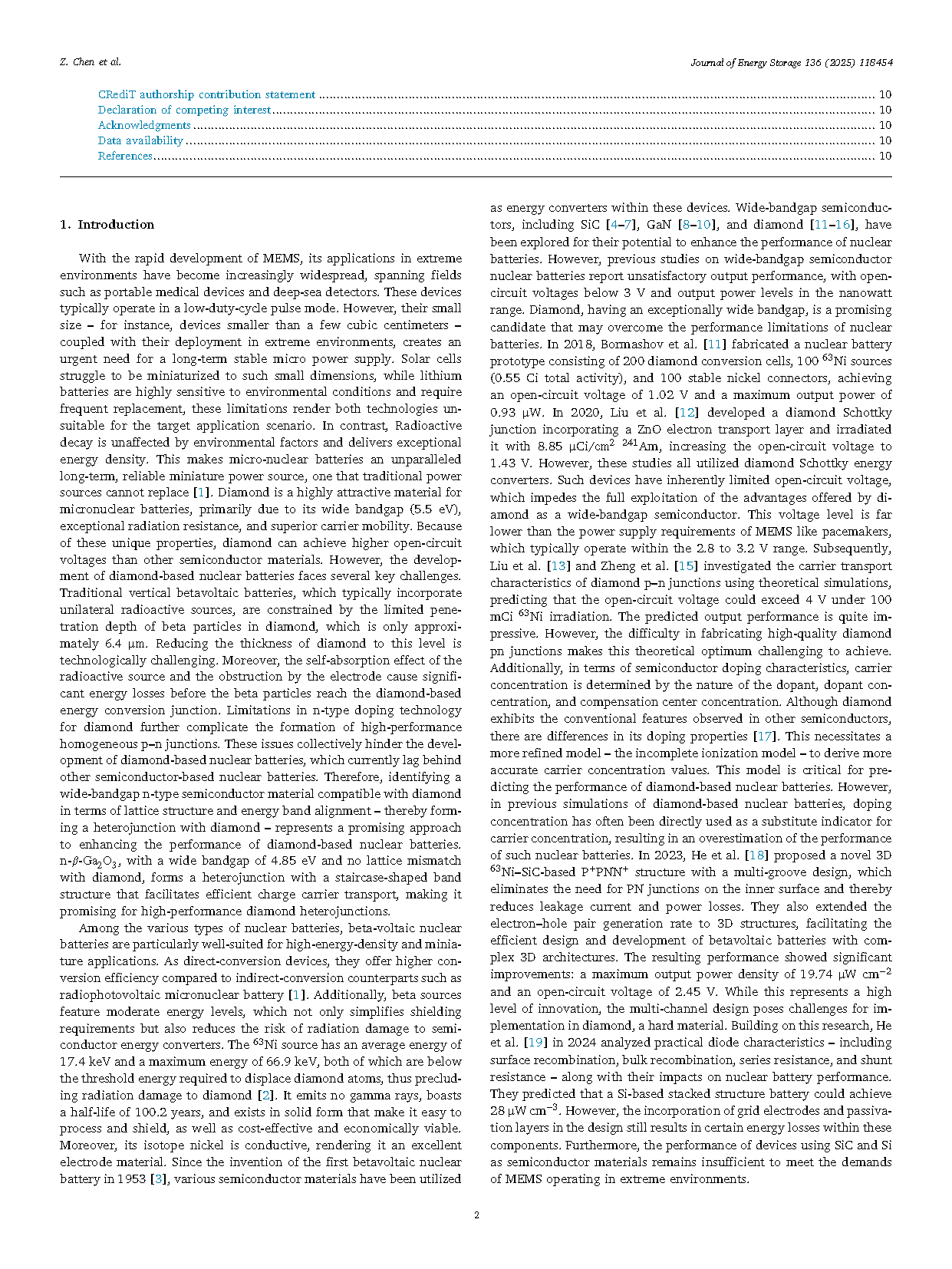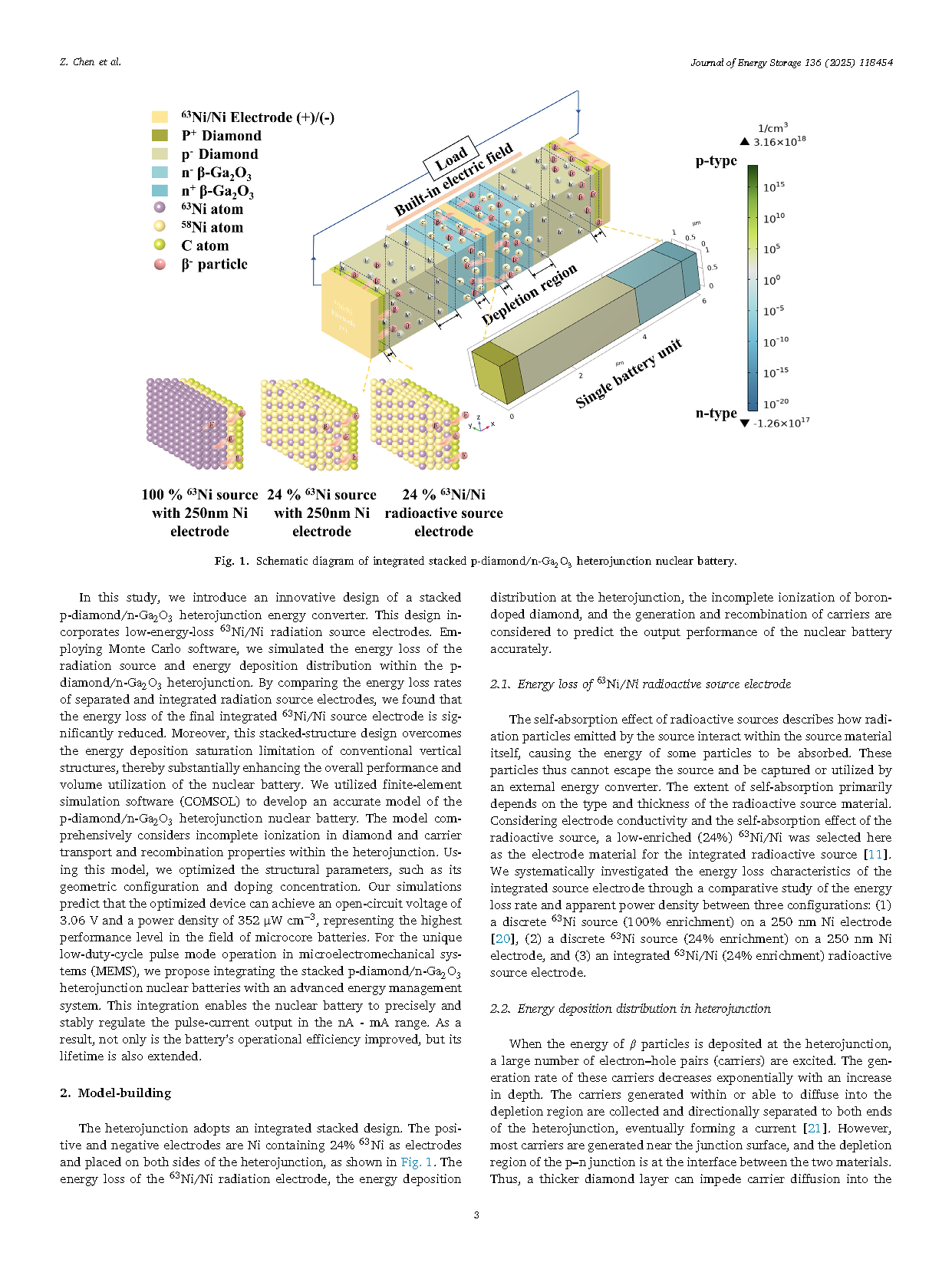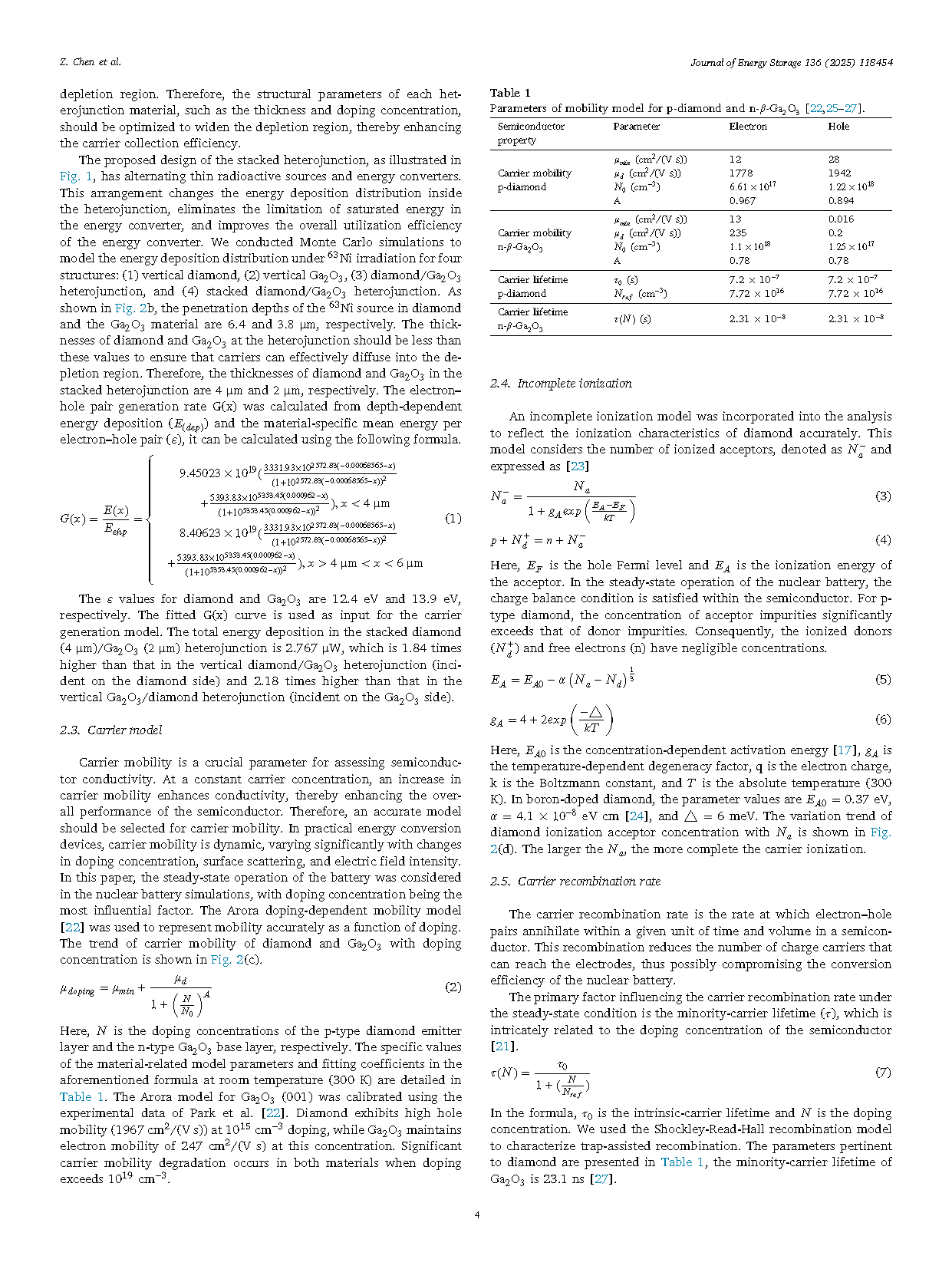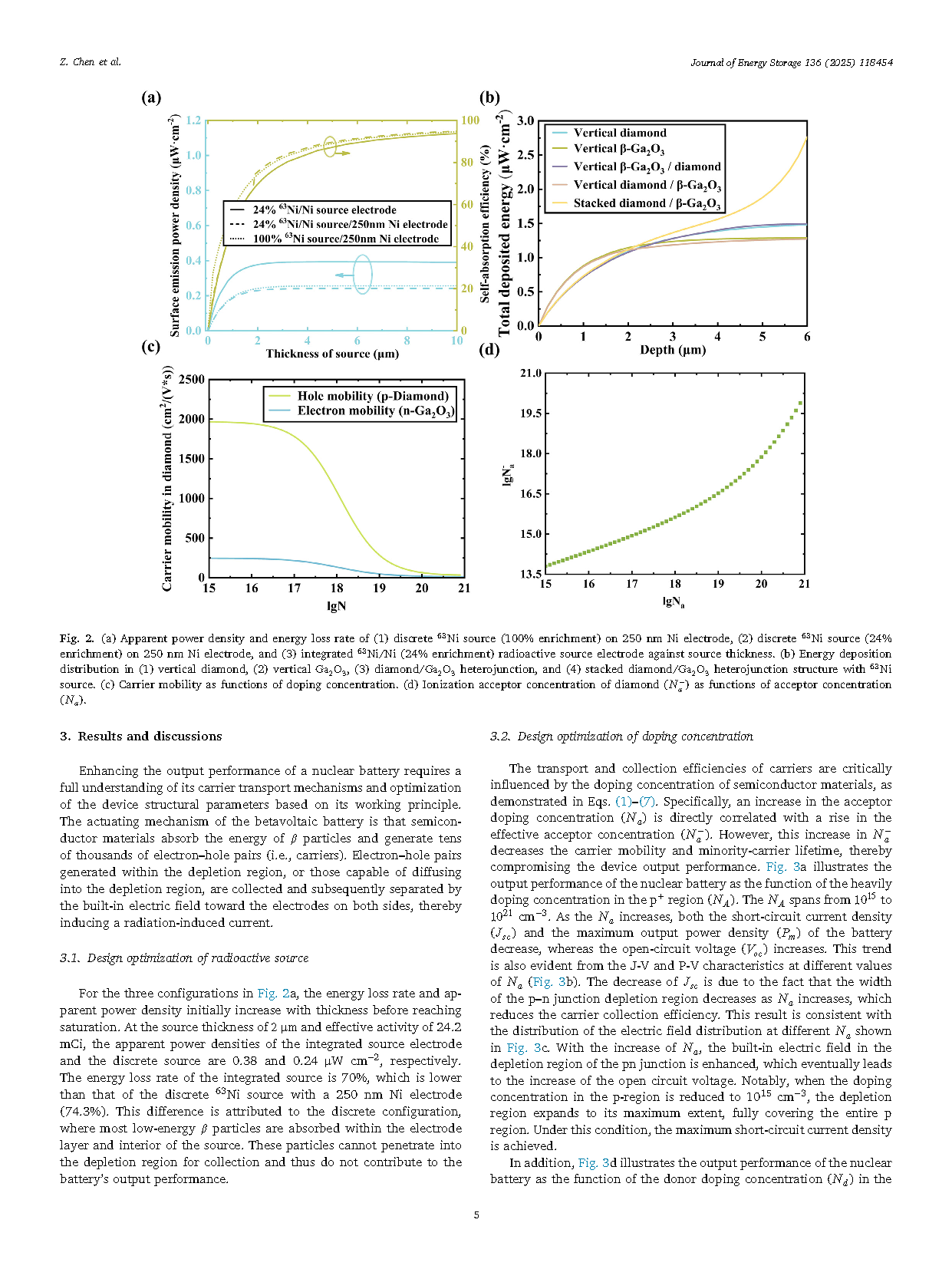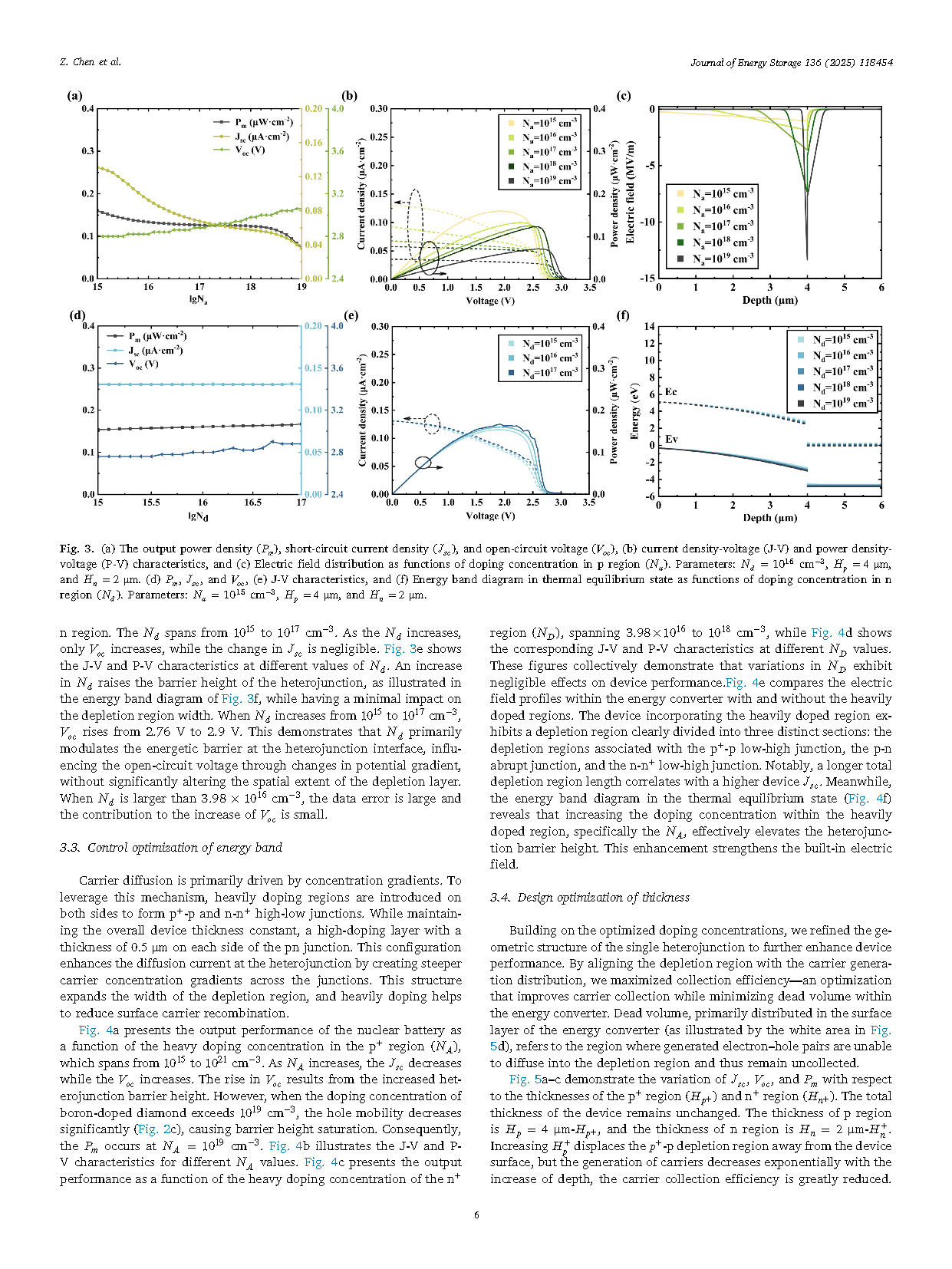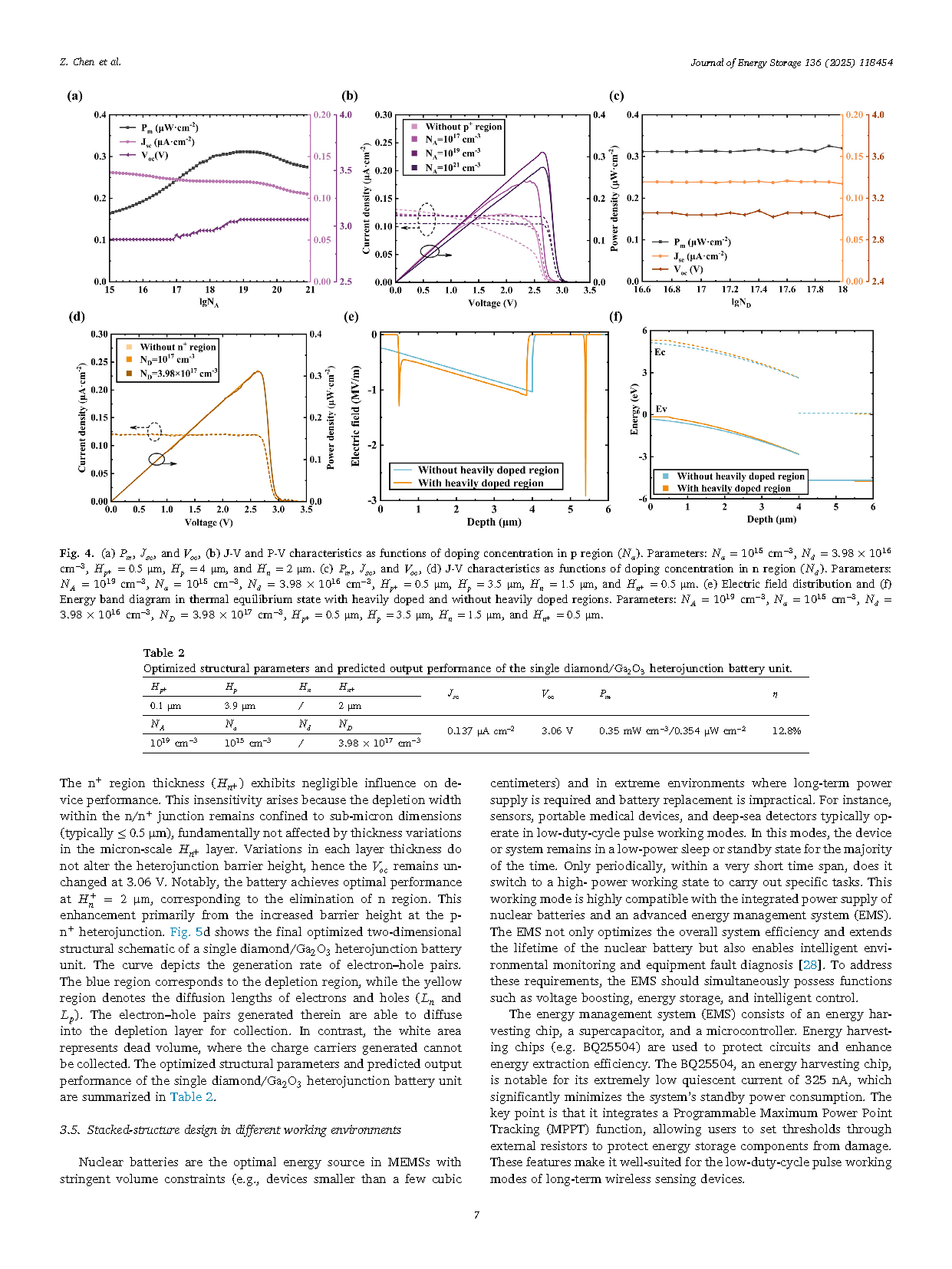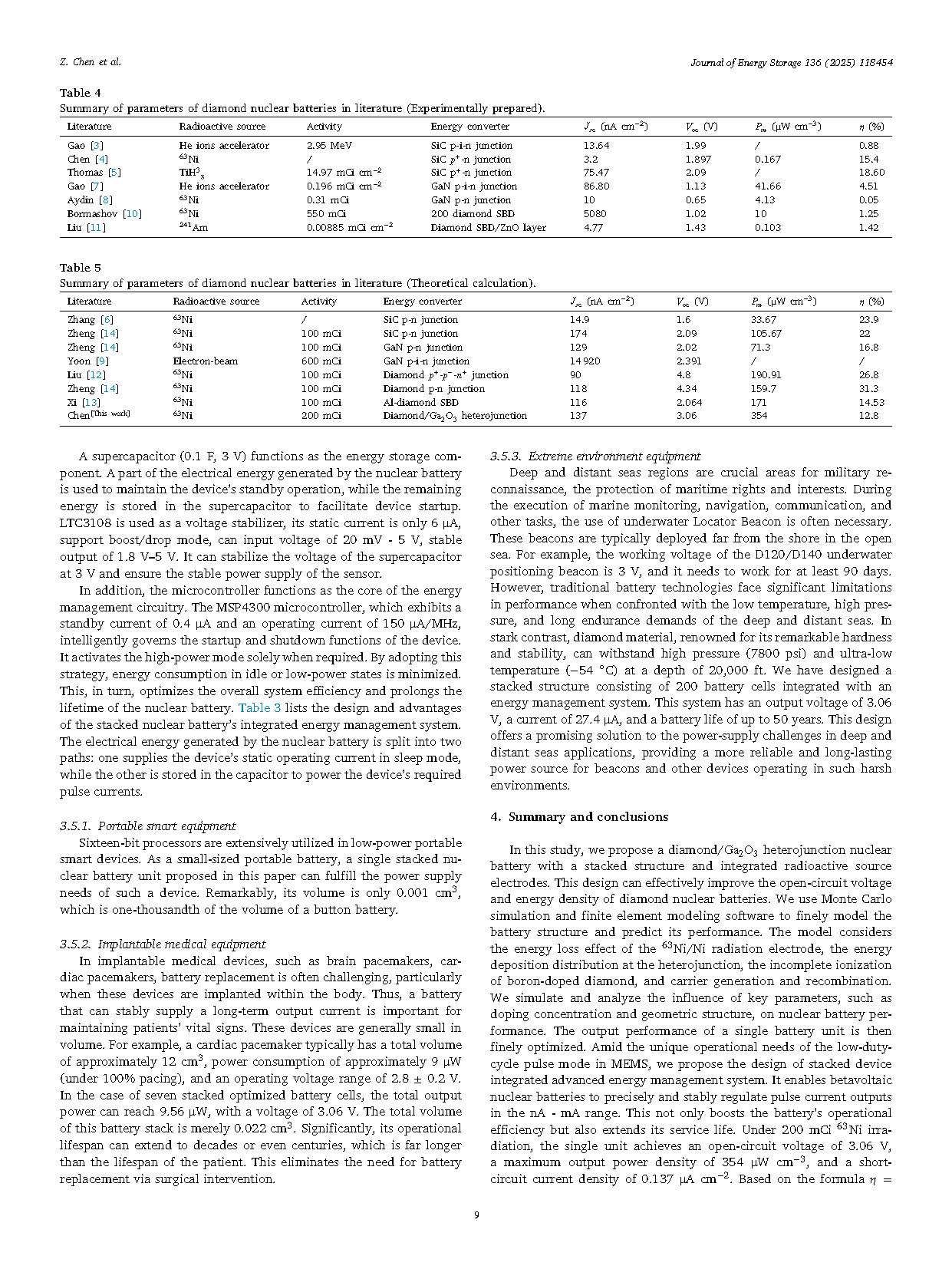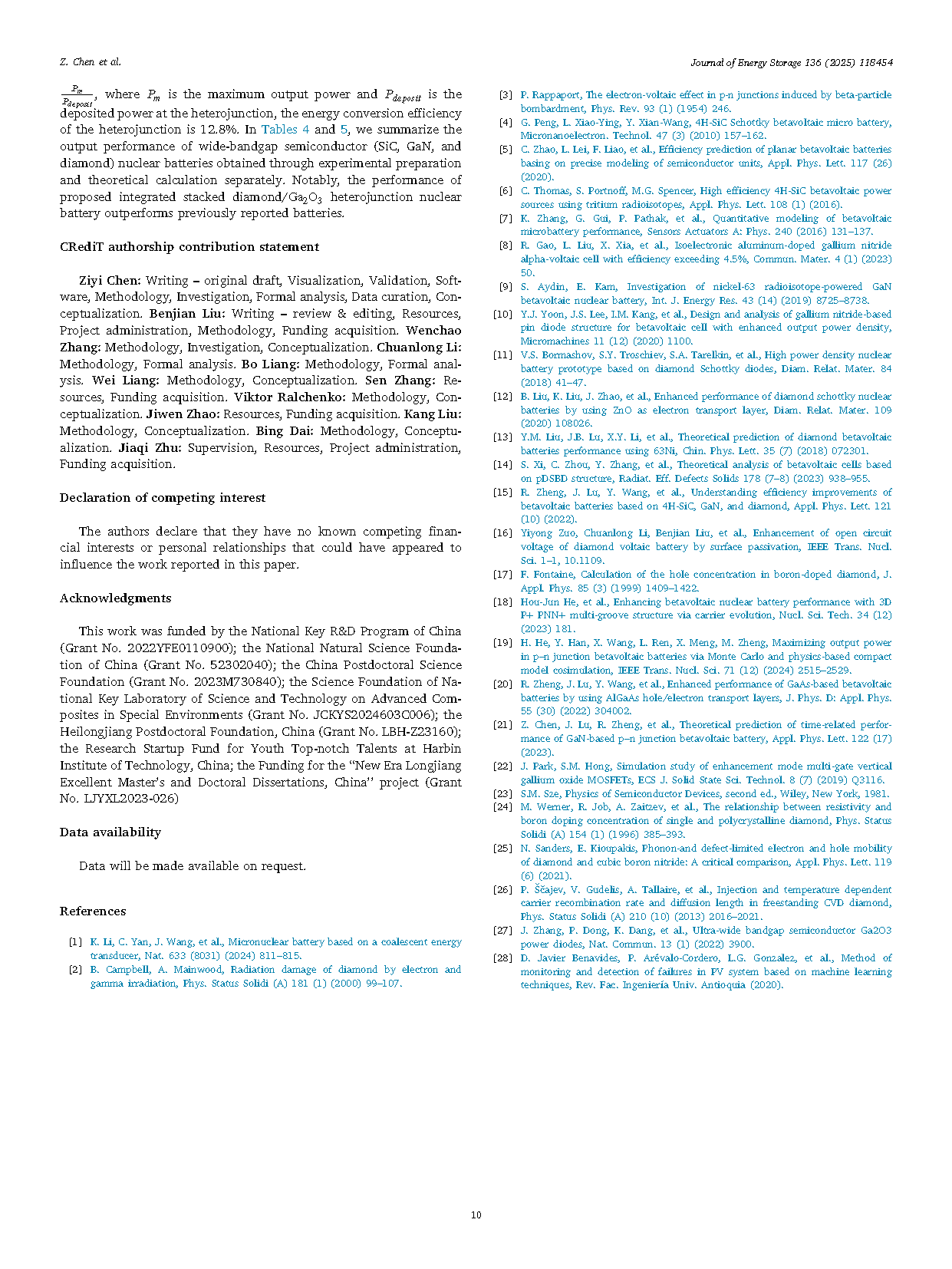
【Member Papers】High open-circuit voltage nuclear batteries enabled by integrated stacked p-diamond/n-Ga₂O₃ heterojunction
日期:2025-09-29阅读:77
Researchers from the Harbin Institute of Technology have published a dissertation titled "High open-circuit voltage nuclear batteries enabled by integrated stacked p-diamond/n-Ga2O3 heterojunction" in Journal of Energy Storage.
Project Support
This work was funded by the National Key R&D Program of China (Grant No. 2022YFE0110900); the National Natural Science Foundation of China (Grant No. 52302040); the China Postdoctoral Science Foundation (Grant No. 2023M730840); the Science Foundation of National Key Laboratory of Science and Technology on Advanced Composites in Special Environments (Grant No. JCKYS2024603C006); the Heilongjiang Postdoctoral Foundation, China (Grant No. LBH-Z23160); the Research Startup Fund for Youth Top-notch Talents at Harbin Institute of Technology, China; the Funding for the “New Era Longjiang Excellent Master’s and Doctoral Dissertations, China”project (Grant No. LJYXL2023-026).
Background
With the rapid development of MEMS, its applications in extreme environments have become increasingly widespread, spanning fields such as portable medical devices and deep-sea detectors. These devices typically operate in a low-duty-cycle pulse mode. However, their small size – for instance, devices smaller than a few cubic centimeters – coupled with their deployment in extreme environments, creates an urgent need for a long-term stable micro power supply. Solar cells struggle to be miniaturized to such small dimensions, while lithium batteries are highly sensitive to environmental conditions and require frequent replacement, these limitations render both technologies unsuitable for the target application scenario. In contrast, Radioactive decay is unaffected by environmental factors and delivers exceptional energy density. This makes micro-nuclear batteries an unparalleled long-term, reliable miniature power source, one that traditional power sources cannot replace.
Abstract
Nuclear batteries, characterized by compact size, long lifetime, and high stability, serve as an alternative power source tailored for extreme environments. Their large-scale application, however, is hindered by high energy loss in radioactive sources and low energy conversion efficiency in energy converters. Diamond, with its strong radiation resistance, ultra-wide bandgap, and high carrier mobility, holds promise as the most viable energy converter material for nuclear batteries aiming for high open-circuit voltage. In this study, a p-diamond/n-Ga2O3 heterojunction betavoltaic nuclear battery is designed, incorporating an innovative stacked heterojunction structure and a low-energy-loss 63Ni/Ni radioactive source electrode. Such a structural integration significantly enhances energy deposition and carrier collection efficiency. Through the optimization of semiconductor characteristics and key structural parameters, the battery achieves an open-circuit voltage of 3.06 V, a conversion efficiency of 12.8%, and a power density of 354 μW·cm−3 under 200 mCi 63Ni irradiation, surpassing previously reported wide-bandgap semiconductor nuclear batteries in output performance. Addressing the unique operational demands of low-duty-cycle pulse-mode micro-electromechanical systems in extreme environments, betavoltaic nuclear battery integrated with an advanced energy management system is proposed. This design enables the betavoltaic nuclear battery to regulate pulse current output precisely and stably within the nA-mA range, enhancing both operational efficiency and service life while enabling intelligent environmental monitoring and equipment fault diagnosis.
Highlights
● p-diamond/n-Ga2O3 heterojunction betavoltaic battery for extreme environment power.
● Stacked diamond nuclear batteries achieve 3.06 V open-circuit voltage.
● Integrated 63Ni/Ni radioactive electrode reduces energy loss by 4%, improves efficiency.
● Betavoltaic battery reaches 354 μW cm−3 via optimized semiconductors and structure.
● Powers low-duty-cycle MEMS with advanced energy management systems.
Conclusion
In this study, we propose a diamond/Ga2O3 heterojunction nuclear battery with a stacked structure and integrated radioactive source electrodes. This design can effectively improve the open-circuit voltage and energy density of diamond nuclear batteries. We use Monte Carlo simulation and finite element modeling software to finely model the battery structure and predict its performance. The model considers the energy loss effect of the 63Ni/Ni radiation electrode, the energy deposition distribution at the heterojunction, the incomplete ionization of boron-doped diamond, and carrier generation and recombination. We simulate and analyze the influence of key parameters, such as doping concentration and geometric structure, on nuclear battery performance. The output performance of a single battery unit is then finely optimized. Amid the unique operational needs of the low-dutycycle pulse mode in MEMS, we propose the design of stacked device integrated advanced energy management system. It enables betavoltaic nuclear batteries to precisely and stably regulate pulse current outputs in the nA - mA range. This not only boosts the battery’s operational efficiency but also extends its service life.
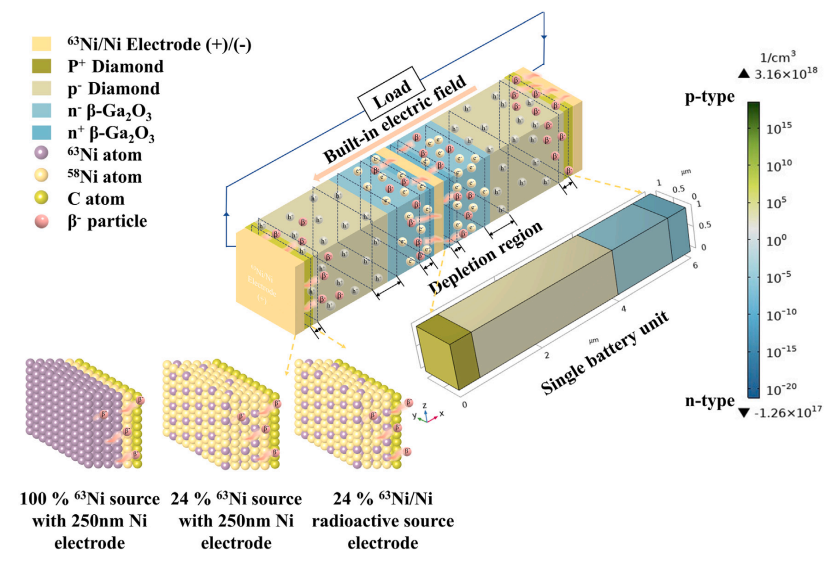
Fig. 1. Schematic diagram of integrated stacked p-diamond/n-Ga2O3 heterojunction nuclear battery.
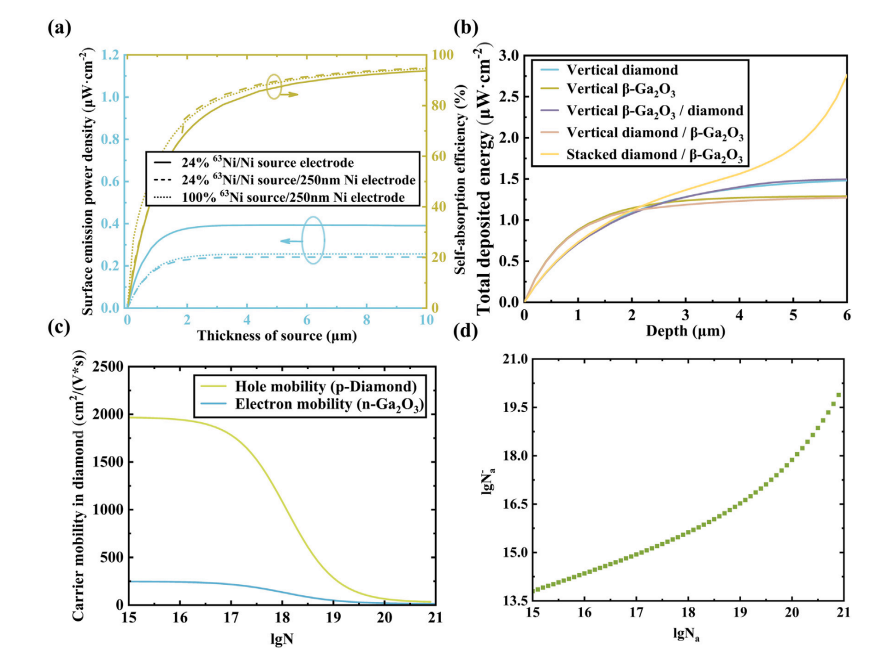
Fig. 2. (a) Apparent power density and energy loss rate of (1) discrete 63Ni source (100% enrichment) on 250 nm Ni electrode, (2) discrete 63Ni source (24% enrichment) on 250 nm Ni electrode, and (3) integrated 63Ni/Ni (24% enrichment) radioactive source electrode against source thickness. (b) Energy deposition distribution in (1) vertical diamond, (2) vertical Ga2O3, (3) diamond/Ga2O3 heterojunction, and (4) stacked diamond/Ga2O3 heterojunction structure with 63Ni source. (c) Carrier mobility as functions of doping concentration. (d) Ionization acceptor concentration of diamond (Na-) as functions of acceptor concentration (Na).
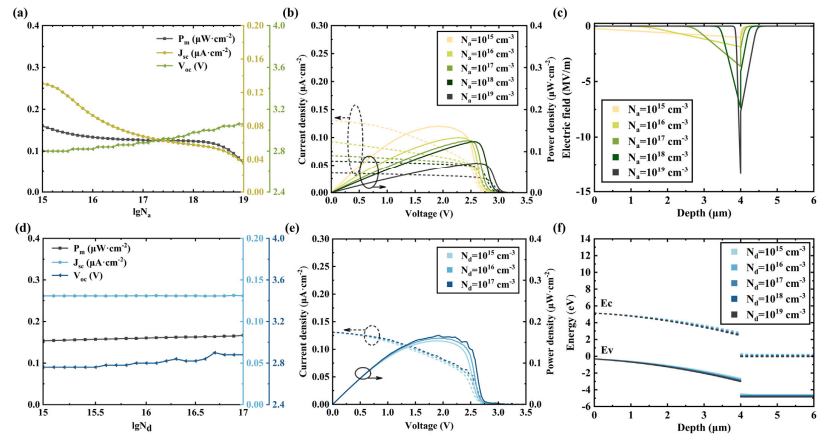
Fig. 3. (a) The output power density (Pm), short-circuit current density (Jsc), and open-circuit voltage (Voc), (b) current density-voltage (J-V) and power density-voltage (P-V) characteristics, and (c) Electric field distribution as functions of doping concentration in p region (Na). Parameters: Nd = 1016 cm−3, Hp= 4 μm, and Hn= 2 μm. (d) Pm, Jsc, and Voc, (e) J-V characteristics, and (f) Energy band diagram in thermal equilibrium state as functions of doping concentration in n region (Nd). Parameters: Na = 1015 cm−3, Hp = 4 μm, and Hn = 2 μm.
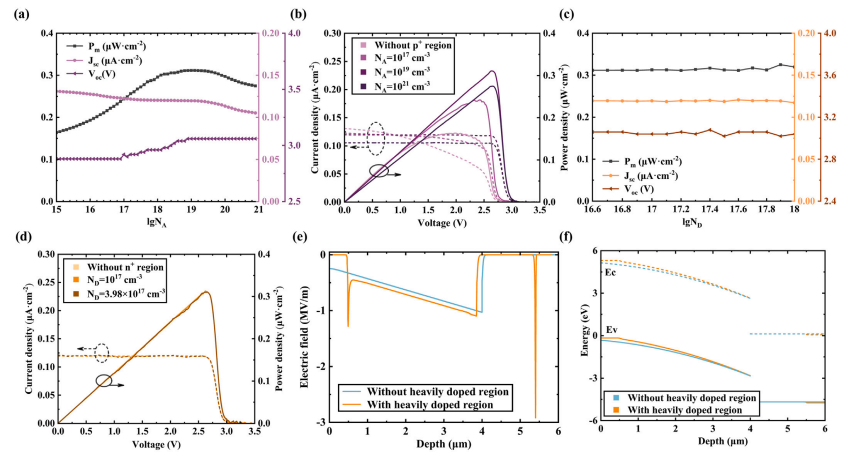
Fig. 4. (a) Pm, Jsc, and Voc, (b) J-V and P-V characteristics as functions of doping concentration in p region (Na). Parameters: Na = 1015 cm−3, Nd = 3.98 × 1016 cm−3, Hp+ = 0.5 μm, Hp = 4 μm, and Hn = 2 μm. (c) Pm, Jsc, and Voc, (d) J-V、P-V characteristics as functions of doping concentration in n region (Nd). Parameters: Na = 1015 cm−3,Nd = 3.98 × 1016 cm−3,Na = 1019 cm−3,Hp+ = 0.5 μm,Hp = 3.5 μm,Hn = 1.5 μm, and Hn+ = 0.5 μm. (e) Electric field distribution and (f) Energy band diagram in thermal equilibrium state with heavily doped and without heavily doped regions. Parameters: Na = 1019 cm−3,Na = 1015 cm−3,Nd = 3.98 × 1016 cm−3,Nd = 3.98 × 1017 cm−3,Hp+ = 0.5 μm,Hp = 3.5 μm,Hn = 1.5 μm,and Hn+ = 0.5 μm。
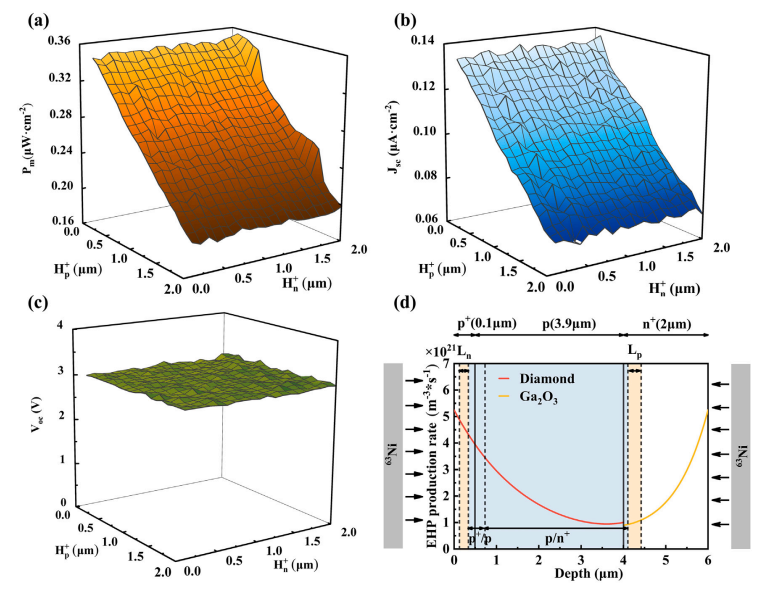
Fig. 5. (a) Pm, (b) Jsc, and (c) Voc as functions of thickness of p+ region (Hp+) and n region (Hn+). Parameters: NA = 1019 cm−3,Na = 1015 cm−3,Nd = 3.98×1016 cm−3,ND = 3.98×1017 cm−3,Hp = 4 μm - Hp+,and Hn = 2 μm - Hn+. (d) The optimized 2D structure diagram of the single diamond/Ga2O3 heterojunction battery unit. Parameters: NA = 1019 cm−3,Na = 1015 cm−3,ND = 3.98×1017 cm−3,Hp+ = 0.1 μm,Hp = 3.9 μm,and Hn+ = 2 μm.
DOI:
doi.org/10.1016/j.est.2025.118454
